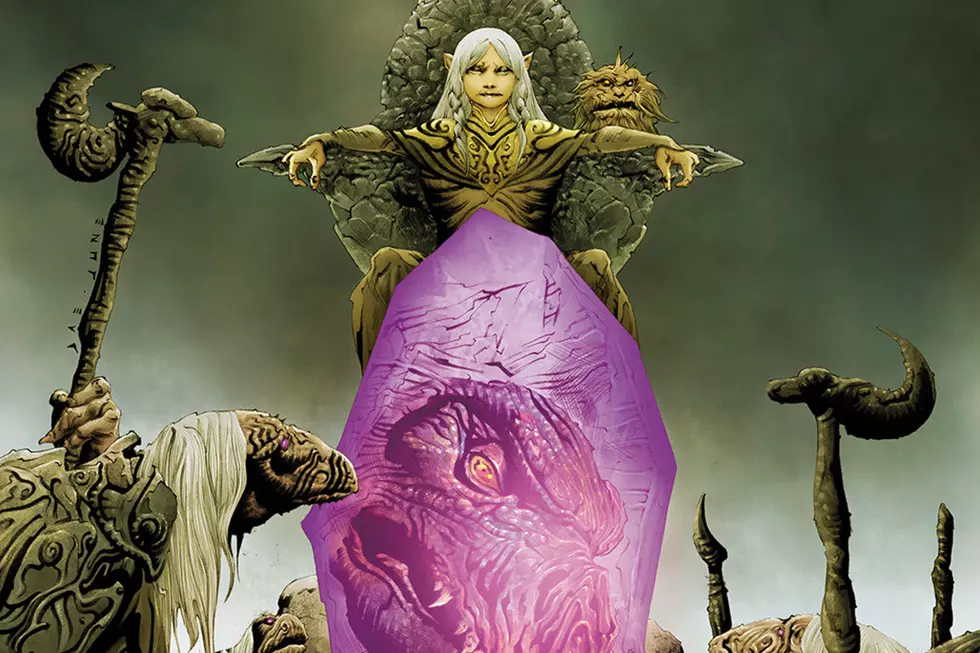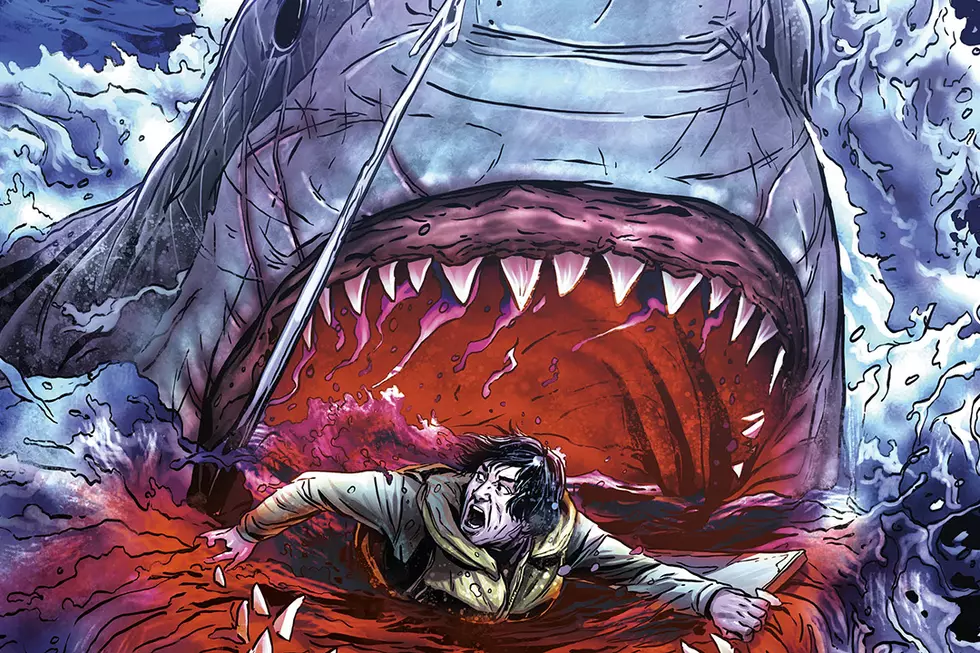![Rooting For The Shark: Si Spurrier Builds A Smarter, Scarier ‘Hook Jaw’ [Interview]](http://townsquare.media/site/622/files/2016/12/Hookjaw1_01_Cover-A.jpg?w=630&h=956&zc=1&s=0&a=t&q=89&w=980&q=75)
Rooting For The Shark: Si Spurrier Builds A Smarter, Scarier ‘Hook Jaw’ [Interview]
This week sees the release of Titan Comics' Hook Jaw re-imagining by Si Spurrier, Conor Boyle, Guilia Brusco and Rob Steen, which brings the violent British environmentalist shark horror comic of the 1970s into the 21st century.
Ahead of the book's debut, ComicsAlliance chatted with Spurrier to find out how well he knew the original strip, what sort of research he had to do, and how he was able to get inside the head of a shark (metaphorically speaking, that is).
ComicsAlliance: Hook Jaw (originally Hookjaw) is a classic British comic series, and was the subject of much controversy at the time. How familiar were you with the original series heading into the revamp?
Si Spurrier: Relatively familiar. Moreso in the mythic sense than specifically, I guess. Bear in mind I got into comics via 2000 AD, which owes a lot of its creative genes to HJ (Hook Jaw)'s first home, Action, which ran for one pulse-poundingly gory year in 1976-77.
To an extent the strips which ran in that mag have always felt like the dark ancestral portraits hanging in 2000 AD's creepiest cloister. One can't really do anything in the punky, countercultural sci-fi oeuvre (which is so central to British comics) without feeling the grim eye of Action glaring from the picture-rail like Uncle Grimdark.
I'd seen enough of the original HJ strip in dribs and drabs over the years to be familiar with it, but it wasn't until more recently I took a dedicated plunge.
CA: Did you get the chance to read all the old Pat Mills stuff before starting out on the new take?
SS: Mills, [Ken] Armstrong and [Ramon] Sola, more specifically --- plus a few other guest artists along the way.
I think I'd managed to track down the lion's share of the original work before starting the new project, yeah. Enough to know that Hook Jaw 2017 should nod at its primogenitor with great affection and respect, but needn't --- in fact should even try to --- slavishly recreate or reboot.
The new strip sets out to tell a tight, thrilling story with all the gory horror you'd expect of a tale with Hook Jaw's pedigree, but to adopt a very modern twist on its preoccupying themes. That is: ecology, the nature of heroism, and the sheer galloping godawfulness of humanity.
CA: How much research goes into working on a marine biology-themed comic?
SS: Quite a bit, in this case. It helped that I was already an ocean-nut, and more so that our editor when embarking was Steve White, who knows more about sharks than most people know about people. All the same: there are a lot of new books on my shelf, and a lot of really horrible images in my search history.
The real beauty of all this is that with even the slightest bit of research it quickly turns out sharks in general --- and Great Whites in particular --- are a million times more fascinating, mysterious and impressive just by being themselves, than the current crop of wanky sharksploitation B-movies could ever make them with all their techno-hybrids, tentacled CGI and shrieking bikini cliches. Even the cinematic elephant in the room, Jaws, on whose coat tails the original Hook Jaw set out pretty explicitly to ride to glory, leans on a bunch of super lazy assumptions about its eponymous monster. The notion of sharks as dumb, solitary, indiscriminately murderous eating machines was already shabby by the standards of Jaws's day --- by today's orthodoxy it's positively primitive.
Happily for those of us telling stories about them, our burgeoning understanding of sharks simply makes them even more impressive, and frankly even more mysterious, than they were before. We know a lot, and we know that we don't know a great deal more.
With Hook Jaw we've worked hard to lace a lot of really cool science into the new story --- all to its gory, thrilling, funny, strange, surprising benefit.
CA: How do you get into the head of a shark to write narrative captions? What was the decision behind giving the reader that insight?
SS: It just grew naturally out of the first few sequences we put together, I think. The aim was to provide a veeeeerrry slight bridge between the reader and the shark.
On the one hand that allows the audience to recognise HJ as a proactive character of sorts (shucking off the legacy of that old "dumb eating machine" bull----). At the same time it's important for the stakes and sympathies of the story that readers never forget the shark isn't human. It's about as alien a psyche as we could ever imagine, and I frankly relished the opportunity to imagine what that might feel like. A world of electrical sensations, ruled by a small number of biological imperatives and a hugely complicated social code.
It's a very “me” conceit, anyway.
It also serves as a very sneaky horror mechanism. Within a couple of issues we get to the point that simply reading the word “flesh” in a panel quietly, the readers know that --- even if you can't see it --- ole' HJ is nearby...
CA: The original was quite cutting edge with its take on environmentalism. How much is that going to be a factor in the new series?
SS: Yeah, very much so, although in rather different ways.
The story loosely revolves around the appearance of a group of female great whites off the coast of Somalia. They're affectionately known as “the Virgin Brides” by the marine biologist who's been studying them for years, and given the names of catholic saints --- Agatha, Bertha, Carmel and Dorothy. One of the big mysteries throughout the arc relates to why these girls are hanging out off Somalia, whose waters have been misused atrociously for decades by first-world powers dumping all manner of toxic crap. In fact there's a big argument to be made for the rise of Somali Piracy --- which everyone's heard of--- being directly related to the collapse of the local fishing industry, caused directly by the criminal abuse of the local waters. Which very few people have heard of.
So yeah, environmental issues are definitely part of the recipe here. Although I'd tend to file them under a broader category of humanity's daft, groping attempts to Be Right. “F---witted Interventionism”, for want of a better term.
One of the wonderful conceits of the first Hook Jaw series was that all the human characters were such unreconstructed b-----ds one quickly came to root for the Shark, dumb eating machine though it was. What started out as an unashamed “dead-crib” of the movie Jaws achieved a far cleverer position by casting the monster in the role of divine arbiter: an avatar of eco-vengeance upon callous humanity.
In the new book we've continued to play with hero/villain conventions in a new way. In our tale almost every human character thinks they're the hero of the story. They're all wrong. Our protagonist Mag is pretty much the only one who doesn't want to play the hero --- she just wants to be left alone.
Unfortunately for her, gigantic half-starving great whites --- particularly ones being driven mad by a sense-boggling shaft of metal lodged in its face --- don't much care whether you want to be left alone or not.
CA: Hook Jaw also focuses on Somali pirates and loose cannon Navy SEALS, but it’s played almost for laughs. Was injecting levity into such serious situations an important decision?
SS: Definitely. Comic relief is the greatest force in all of horror. There's no creeping dread without a sigh of relief and a nervous chuckle.
That's especially true when you're playing with the nature of heroism. In typically perverse narrative fashion we wanted to present an array of characters who --- in any other story --- would play the protagonists. And then we set about making them look as pathetic as they truly are.
It's my firmly held belief that there's no healthier response to someone with a saviour complex, and this is as true of real world politicians as it is of swaggering steroidal action heroes with guns, than pointing and laughing at them.
CA: It seems recently comics are finding new ways at conveying characters speaking in languages other than English, and Hook Jaw does some interesting stuff there. Was there direction to the letterer, or was it their discretion?
SS: The basic concept was there in the script, although we asked our letterer Rob Steen to experiment with finding the best solutions. Basically we wanted a simple visual indicator to distinguish between people speaking English and people speaking Somali. The reader can understand both, but the characters can't understand each other.
I hate all that <translated foreign text> stuff, and a lot of the other visual solutions are insensitive at best and downright racist at worst. Instead we decided to simply shift the background tone of the balloons and use a marginally different typeface. It sets up some nice plot moments with characters unable to communicate, and some vindictively funny moments with garbled translations and racist a--holes making assumptions.
Hook Jaw #1 goes on sale Wednesday 21 December 2016. Check out more variant covers below:
More From ComicsAlliance
![Si Spurrier and Jonas Goonface Promise A God For (Almost) Every Human in ‘Godshaper’ [Interview]](http://townsquare.media/site/622/files/2017/01/BOOM_Godshaper_FEATURED.jpg?w=980&q=75)

![A Real Human Being, And A Real Hero: Gary Phillips On ‘Vigilante: Southland’ [Interview]](http://townsquare.media/site/622/files/2016/10/Vigilante-Feat.png?w=980&q=75)

![Get Ready For All Skulls, All The Time In ‘Warhammer 40,000′ #1 [Preview]](http://townsquare.media/site/622/files/2016/09/WH40K.jpg?w=980&q=75)

![Titan Revives Sharksploitation Comic ‘Hookjaw’ With Spurrier And Boyle [SDCC 2016]](http://townsquare.media/site/622/files/2016/07/Hookjaw-Featured.jpg?w=980&q=75)

![World Building: Character And Color in Stokely And Spurrier’s ‘The Spire’ [Pride Week]](http://townsquare.media/site/622/files/2016/06/PrideWeek-Spire.jpg?w=980&q=75)
